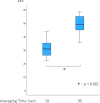Effect of averaging time and respiratory pause time on the measurement of acoustic respiration rate monitoring
- PMID: 37773551
- PMCID: PMC10541352
- DOI: 10.1186/s40981-023-00654-4
Effect of averaging time and respiratory pause time on the measurement of acoustic respiration rate monitoring
Abstract
Background: Acoustic respiration rate (RRa) monitoring is a method of continuously measuring respiratory rate using a signal from an acoustic transducer placed over the airway. The purpose of the present study is to examine how the averaging time and respiratory pause time settings of an RRa monitor affect the detection time of sudden respiratory rate changes.
Methods: A total of 40 healthy adult volunteers were included in the study. First, we measured the apnea detection time (apnea test) by dividing them into two groups (N = 20 each), one with a respiratory pause time setting of 20 s and the other with 40 s. Each group performed two apnea tests with an averaging time setting of 10 and 30 s. Next, we measured the tachypnea detection time (tachypnea test) for half of the subjects (N = 20) with two averaging time settings of 10 and 30 s. For each test, three measurements were taken, and the average of the three measurements was recorded.
Results: There was no significant difference in the apnea detection time between the averaging time set at 10 and 30 s regardless of whether the respiratory pause time was set at 20 or 40 s. However, the apnea detection time was significantly shorter with the respiratory pause time of 20 s than 40 s, regardless of whether the averaging time was set at 10 or 30 s (p < 0.001). The tachypnea detection time was shorter with the averaging time of 10 s than 30 s (p < 0.001). Furthermore, the apnea detection time and tachypnea detection time were much longer than the actual settings.
Conclusions: The results of the current study show that in the measurement of RRa, the apnea detection time is more affected by the respiratory pause time setting than the averaging time setting; however, the tachypnea detection time is significantly affected by the averaging time setting.
Keywords: Acoustic respiration rate monitoring; Apnea; Averaging time; Respiratory pause time; Tachypnea.
© 2023. The Japanese Society of Anesthesiologists.
Conflict of interest statement
The authors declare that they have no competing interests.
Figures


References
-
- Bergum D, Nordseth T, Mjølstad OC, Skogvoll E, Haugen BO. Causes of in-hospital cardiac arrest – incidences and rate of recognition resuscitation. 2015;87:63–8. 10.1016/j.resuscitation.2014.11.007 - PubMed
-
- Weinger MB, Lee LA. No patient shall be harmed by opioid-induced respiratory depression. Circulation. 2011;26:21.
LinkOut - more resources
Full Text Sources
